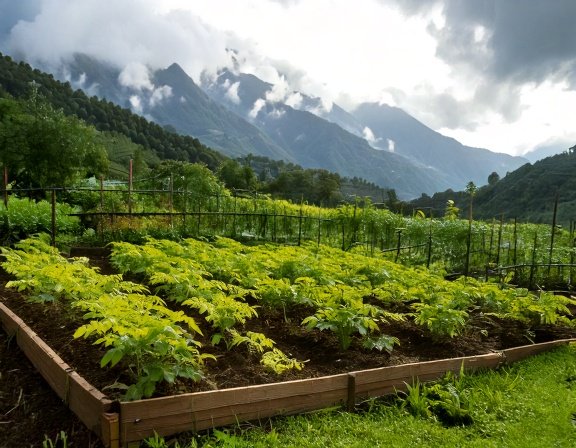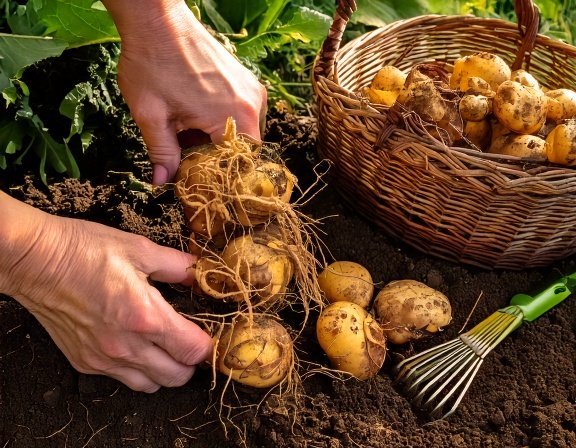Growing Maca in Your Garden: Step-by-Step Guide to Planting, Care & Harvesting for Energy & Hormone Balance

Root Medicine Grower’s Guide (PDF)
Want a printable quick-start for all root adaptogens, including maca? Get your PDF guide with planting calendars, troubleshooting, and energy-boosting recipes.
Download Free GuideFrom high mountain earth to your backyard bed—maca root energizes, balances, and restores. Maca root (Lepidium meyenii) is a legendary adaptogen from the Andes, renowned for boosting energy, resilience, and hormone balance. Did you know you can grow this superfood in your own garden? Whether you’re aiming to naturally support vitality, stamina, or reproductive health, maca’s hearty root can be cultivated with a little know-how and patience. In this guide, discover how to plant, care for, and harvest maca—plus simple ways to use your homegrown roots for wellness and vitality.

How to Plant Maca in Your Garden: Step-by-Step
How to Plant Maca in Your Garden: Step-by-Step
Maca (Lepidium meyenii), a hardy root vegetable native to the Andes, can adapt surprisingly well to temperate home gardens when given the right conditions. Its secret to success lies in well-drained soil, cool nights, and steady, patient growth. Here’s how to plant and nurture maca in your own garden from seed to harvest.
1. Choose the Right Spot:
Select a location with full sun to partial shade and good air circulation. Maca prefers cooler daytime temperatures (60–75°F / 15–24°C) and thrives with chilly nights, which encourage robust root formation.
2. Prepare the Soil:
Maca grows best in loose, sandy, well-drained soil with a slightly acidic pH (5.5–6.5). Mix in compost or well-aged manure to boost nutrients and improve texture. Avoid heavy clay or compacted soil, which can stunt root development. A raised bed or deep container with drainage holes works well for control and root aeration.
3. Planting the Seeds:
Sow maca seeds directly into the soil in early spring once the ground can be worked. Scatter seeds thinly, then gently press them into the soil surface or cover with a light layer (¼ inch or less) of soil. Keep the soil evenly moist but never soggy.
4. Spacing & Thinning:
When seedlings reach about 2–3 inches tall, thin them to 4–6 inches apart in rows spaced 10–12 inches apart. This gives each plant room to form a healthy root bulb underground. The young greens are edible—add the thinnings to salads for a mild, peppery flavor.
5. Watering & Care:
Water maca regularly to maintain lightly moist soil, especially during dry spells. Overwatering can lead to root rot, so allow the top layer of soil to dry slightly between waterings. Mulch lightly around the base of plants to help retain moisture and keep roots cool.
6. Feeding & Maintenance:
Feed once every 6–8 weeks with compost tea or a diluted organic fertilizer. Avoid excessive nitrogen—it encourages leafy growth at the expense of root development. Keep the bed weed-free to reduce competition for nutrients.
7. Watch for Climate Cues:
Maca enjoys cool nights (40–50°F / 4–10°C). In warmer climates, use shade cloth or mulch to regulate soil temperature. In very hot regions, plant maca as a fall crop when temperatures are more moderate.
8. Patience Pays Off:
Maca is a biennial plant, meaning it takes one full growing season (about 8–9 months) to develop mature roots ready for harvest. Be patient—during its first few months, most growth happens below the surface.
Quick Tip: For best results, mimic the maca’s native highland environment—cool air, mineral-rich soil, and a touch of climate stress. These conditions naturally enhance its adaptogenic compounds and flavor while rewarding you with a powerful, nutrient-dense root come harvest time.
How to Grow Maca
- Seed Selection: Purchase maca seeds from a reputable supplier. Yellow maca is the most common, while red and black varieties offer unique nutrient profiles.
- Soil & Site: Prefers sandy, well-drained, slightly acidic soil (pH 5.8–6.5). Choose a full sun location with good airflow.
- Sowing: Sow seeds directly in early spring after the last frost, about ¼ inch deep, spaced 2–4 inches apart. Water lightly and keep soil moist during germination.
- Spacing: Thin seedlings to 4–6 inches apart as they develop to allow for proper root growth.
- Growing Tip: Maca thrives in cool weather—best grown in spring or fall in temperate climates. Mulch lightly to maintain soil moisture and temperature.

Caring for Your Maca Plants
Once your maca seedlings are established, steady, thoughtful care will help them thrive and develop nutrient-dense roots. Because maca naturally grows in the challenging, high-altitude soils of Peru, it prefers moderate stress—cool nights, mineral-rich earth, and minimal excess moisture. The goal is to mimic those Andean conditions while protecting your plants from extremes.
1. Watering:
Keep the soil consistently moist but never waterlogged. Overwatering can cause root rot, while drought can stunt growth. Water deeply once or twice a week depending on rainfall, allowing the top inch of soil to dry slightly between waterings. Use mulch to help retain moisture and keep roots cool during warmer spells.
2. Sunlight & Temperature:
Maca thrives in full sun to partial shade. It performs best in cool daytime temperatures (60–75°F / 15–24°C) and chilly nights (40–50°F / 4–10°C). In warm climates, consider planting maca in a slightly shaded area or using shade cloth to protect it from intense afternoon heat.
3. Feeding:
Maca doesn’t need heavy fertilization. Every 6–8 weeks, apply a light layer of organic compost or compost tea to replenish nutrients and minerals. Avoid nitrogen-heavy fertilizers, which promote leaf growth instead of root formation.
4. Weeding & Mulching:
Weed regularly to prevent competition for nutrients, but pull weeds carefully to avoid disturbing the shallow maca roots. A thin layer of organic mulch—such as straw or shredded leaves—helps regulate soil temperature and maintain steady moisture.
5. Pests & Diseases:
Maca is generally hardy and pest-resistant. However, root maggots, aphids, or flea beetles can occasionally appear. Use natural deterrents like neem oil or diatomaceous earth around the base of plants. Proper spacing, drainage, and airflow help prevent fungal issues such as root rot or mildew.
6. Climate Care:
In regions with hot summers, water in the early morning and use mulch to cool the soil. In cooler climates, protect young plants from frost by covering them with lightweight fabric or moving containers indoors during cold snaps. Maca appreciates a bit of weather variation—it’s part of what builds its resilience and potency.
7. Observation:
Check your plants weekly. Healthy maca leaves form small, low-growing rosettes that stay close to the soil surface. Yellowing leaves near the end of the season are a normal sign that the plant’s energy is shifting into the root, preparing for harvest.
Quick Tip: Maca thrives when slightly challenged. Gentle stress—cool nights, lean soil, and measured watering—actually increases the concentration of macamides and macaenes, the compounds responsible for its energy-boosting and hormone-balancing properties.
Caring for Your Maca Plants
- Watering: Keep soil consistently moist but never soggy — maca prefers moisture but dislikes “wet feet.”
- Feeding: Side-dress with compost or apply an organic fertilizer every 4–6 weeks for steady nutrient support.
- Weed & Pest Management: Keep beds weed-free to reduce competition. Maca is typically pest-resistant, though aphids and flea beetles may appear occasionally.
- Mulching: Apply a light layer of mulch to help retain moisture, regulate soil temperature, and suppress weeds naturally.

Thyrafemme Balance: Adaptogenic Plant Blend for Women
- Features adaptogens: Ashwagandha, Rhodiola, Lemon Balm, Kelp/Iodine, Schisandra
- Plus selenium, zinc, L-tyrosine for full-spectrum hormone support
- No synthetic hormones—just time-tested botanicals and minerals
Shop Organic Maca Powder – Natural Energy Supplement
Want to try before you grow? Order maca powder or root capsules for sustainable hormone & energy support. (Shop at Amazon)
Shop Maca PicksWhen and How to Harvest Maca
When and How to Harvest Maca
Harvesting maca is a slow and rewarding process that marks the culmination of months of steady growth and care. This hardy Andean root takes time to develop its full nutritional and adaptogenic potential, storing energy in its bulbous roots as temperatures cool. Knowing when and how to harvest maca properly helps preserve its unique flavor, longevity, and potency—ensuring that your homegrown crop delivers the same nourishing strength long valued in traditional Peruvian medicine.
- Harvest Time: 8–10 months after planting, when leaves start to yellow and die back.
- How to Harvest: Carefully dig around each plant, lift roots, and brush off excess soil. Allow roots to sun-dry for a few days, then finish drying indoors.
- Storage: Store dried maca roots in a cool, dry place. Grind into powder as needed.

Simple Ways to Use Homegrown Maca Root
Simple Ways to Use Homegrown Maca Root
Once your maca roots are fully dried and cured, you can enjoy them in a variety of nourishing and energizing ways. Traditionally sun-dried at high altitude to develop flavor and potency, maca roots can be turned into powder, blended into warm tonics, or infused into teas. Its mildly nutty, caramel-like taste pairs beautifully with cacao, cinnamon, and plant-based milks—making it a versatile addition to daily wellness routines.
1. Maca Powder (Most Common Form):
Grind fully dried maca roots into a fine powder using a spice grinder or high-speed blender. Store the powder in an airtight jar and add ½–1 teaspoon daily to smoothies, oatmeal, yogurt, or warm drinks. This is the easiest way to enjoy maca’s energy and hormone-supportive benefits regularly.
2. Maca Tea or Decoction:
Simmer 1–2 teaspoons of dried or powdered maca root in 2 cups of water for 15–20 minutes. Strain and drink warm, optionally adding a touch of honey, cinnamon, or ginger. This soothing drink helps promote calm energy, focus, and steady stamina throughout the day.
3. Maca Latte or Warm Tonic:
Blend maca powder into warm almond or oat milk with a pinch of cinnamon, cacao, and vanilla for a creamy, adaptogenic latte. It’s a perfect caffeine-free alternative for morning focus or an afternoon pick-me-up that doesn’t disturb sleep.
4. Energy Balls or Smoothies:
Mix maca powder into no-bake energy bites with oats, nut butter, and honey, or add to smoothies with banana, cacao, and almond milk. These combinations enhance both flavor and nutrient absorption while sustaining energy levels naturally.
5. Traditional Fermented Maca:
In the Andes, dried maca roots are sometimes lightly fermented before use, enhancing their digestibility and earthy sweetness. You can mimic this by soaking dried maca in warm water overnight, then simmering the liquid to make a rich, slightly tangy tea base.
6. Pairing for Wellness Goals:
- For Hormone Balance: Combine maca with shatavari or ashwagandha for steady energy and emotional calm.
- For Focus & Mood: Blend maca with cacao and cinnamon for a natural dopamine and serotonin boost.
- For Fitness & Endurance: Take maca with a light protein source (like chia or almond milk) 30 minutes before workouts for sustained stamina.
Quick Tip: Start small—just ¼ to ½ teaspoon of maca powder per day—and increase gradually as your body adjusts. Because maca is an adaptogen, its benefits build over time, enhancing both resilience and clarity the longer it’s used.
How to Use Maca Root
Maca Powder: Peel and slice dried maca roots, then grind them in a coffee grinder or blender to make fine powder for daily use.
Maca Smoothie: Add 1–2 teaspoons of maca powder to smoothies for a natural energy, mood, and endurance lift.
Baking & Cooking: Stir maca powder into oatmeal, muffins, pancakes, or energy balls for a nutty, malty flavor and extra nutrition.
Hormone Support: Use maca daily or several times per week to promote balanced energy, stress resilience, and reproductive wellness.

This herbal recipe is shared for educational purposes only, based on traditional use and available sources. It is not medical advice. Please consult your healthcare provider before use, especially if pregnant, nursing, or on medication.
Organic Herb Garden Indoor Kit – Certified Organic & Made in USA
Ready to grow your own? Try this Organic Home Garden Kit by Spade of Fork—ideal for new gardeners and herbalists.
Shop KitAgeless Energy Solution: Restore Balance Naturally
- Focuses on nutrition, gentle movement, and food-based stress relief
- Tips and protocols for hormone and energy balance—no fad diets
- Great for adults seeking natural support for mood and metabolism
Did You Know?
Maca is called “Peruvian ginseng,” though it’s not related to ginseng—it earned its nickname for its energizing, adaptogenic power!
Ready to Grow Your Own Energy Root?
Subscribe to Health Intel Daily for weekly garden medicine tips!